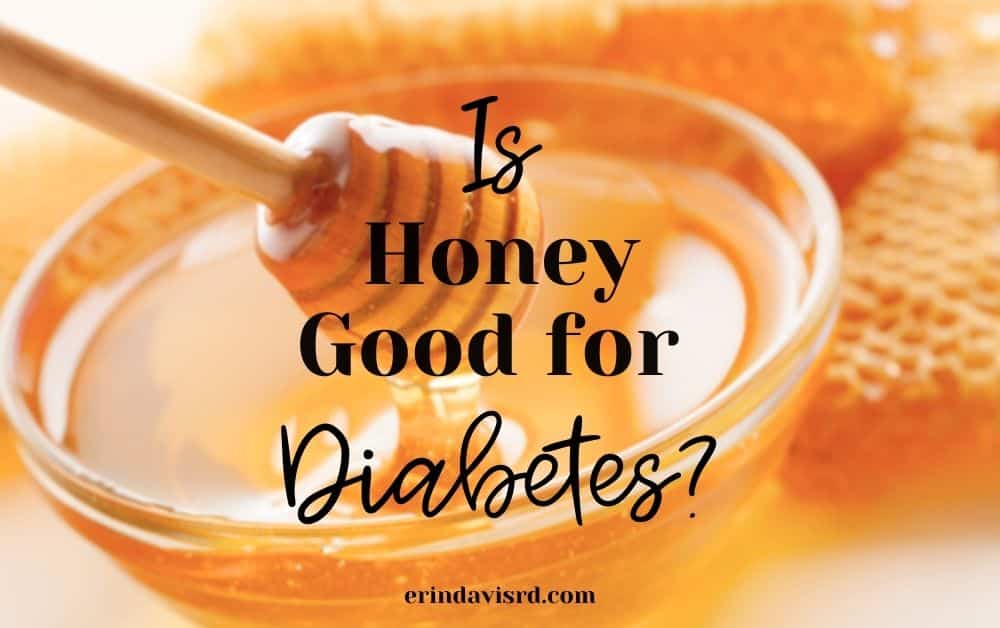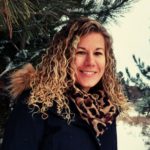Honey has long been cherished for its natural sweetness and numerous health benefits, but what about its role in managing diabetes? Is honey good for diabetes? Today, we’re exploring the benefits of honey and its impact on blood sugar.
For those living with diabetes, balancing blood sugar levels is a daily challenge.
There’s no vacation. You must always attend to your diet, exercise, and blood sugar readings.
As a non-diet dietitian specializing in diabetes management, I want to make that easier for you.
I’m a firm believer that intuitive eating and diabetes can go hand-in-hand. That means you can eat ALL foods, even fast food.
One approach is finding foods that satisfy your cravings while avoiding major spikes in blood sugar.
You’ve likely been told that certain foods are off-limits. But should people with diabetes eat honey?
Interestingly, honey, with its unique composition and health properties, might offer some surprising benefits for diabetes management.
In this post, we’ll review the relationship between honey and diabetes, examining how this natural sweetener can fit into your diet and what the research says about its potential impacts on blood sugar levels and overall health.
Please note: As an Amazon Associate, I earn from qualifying purchases.
How is honey produced?
Let’s start by talking about bees.
Bees are such an important part of the ecosystem, pollinating plants so that we can grow crops.
While the bees are transferring pollen from one plant to the next, they make honey.
It starts with forager honeybees, which suck up nectar from flowers and store it in their honey stomachs.
There, proteins and enzymes digest the nectar into simpler sugars, fructose and glucose.
The forager bee goes back to the hive, where it regurgitates the nectar into the mouths of the house bees.
Nectar starts out pretty thin, but the bees’ digestive enzymes remove water and it begins to thicken.
Worker bees then pack nectar into the cells made of beeswax, or honeycomb.
The nectar is further thickened when the bees create an air current by fanning their wings.
Finally, when it’s honey, the bees seal the cells with wax so the honey remains preserved.
Types of Honey
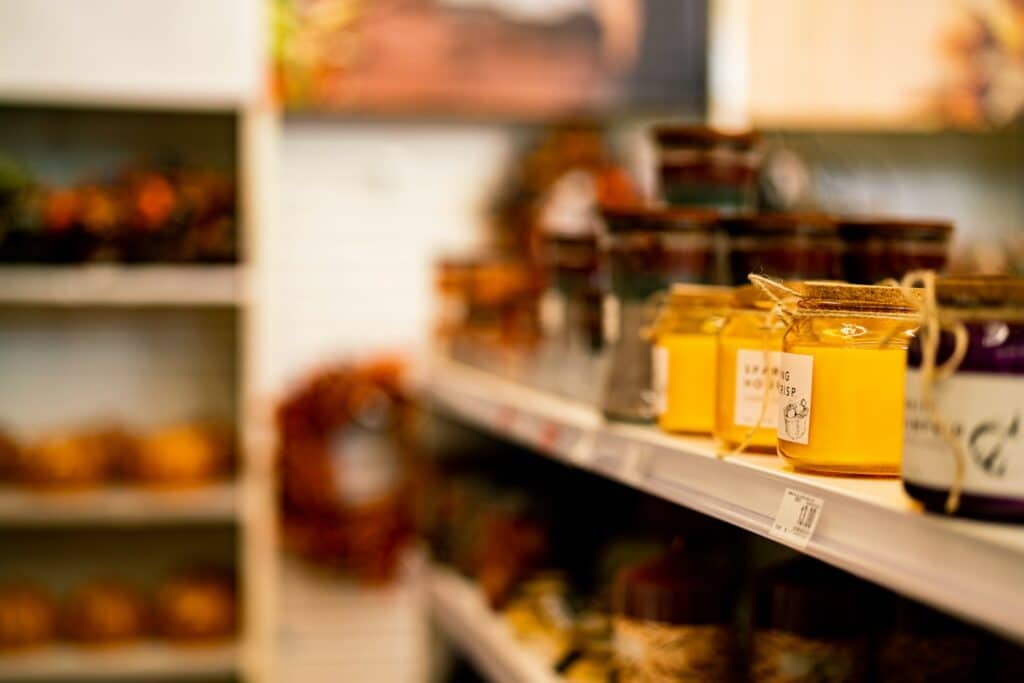
Wondering what the difference is between all of the honey that’s available on the grocery store shelf?
Honey varies based on the type of flower from which the bees gather nectar. Here’s a breakdown of the more common varieties of honey:
Clover Honey: Clover honey is produced by bees that gather nectar from clover flowers, classifying it as a monofloral honey. It’s well-loved for its mild taste and is widely available due to the extensive growth of clover in various climates.
Manuka Honey: Derived from the nectar of the manuka bush found in New Zealand and Australia, this honey has a stronger, earthy flavor and is produced in smaller quantities—resulting in a higher price.
Wildflower Honey: Made from the nectar of various flowers, wildflower honey’s taste and color can vary depending on the season and location of the flowers. It’s often darker and has a richer, stronger flavor compared to clover honey.
Then there is how the honey is processed (or not): pasteurized honey vs. raw honey.
Pasteurization is the process of heating honey to 145-160 degrees and then quickly cooling it to delay crystallization and improve appearance.
This process may also reduce fermentation, extending the honey’s shelf life.
Raw honey is harvested directly from the beehive and is not heated or processed. For this reason, it’s believed that raw honey has more nutrients compared to pasteurized honey.
Because it’s not filtered, raw honey may be a bit cloudy.
Benefits of Honey
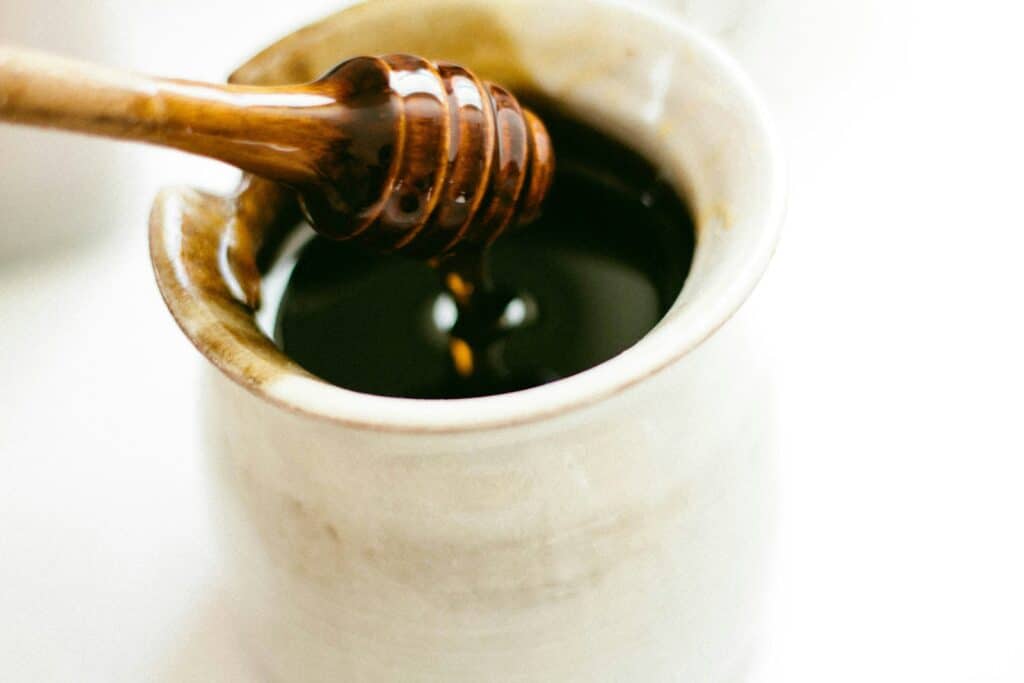
We can’t talk about honey without mentioning its nutrient profile.
Honey is a source of vitamins, like vitamin C and B complex. It also contains calcium, iron, magnesium, and potassium.
It should be noted that the amount of vitamins and minerals in honey is pretty small. You’d have to eat a lot for it to amount to much.
But it’s these nutrients and plant compounds, like flavonoids and polyphenols, that set honey apart from other sweeteners.
Honey is valued for its antioxidant activity. It can soothe sore throats and symptoms of the common cold. Here are some other benefits of honey that are of particular interest for someone with diabetes:
Mouth infections
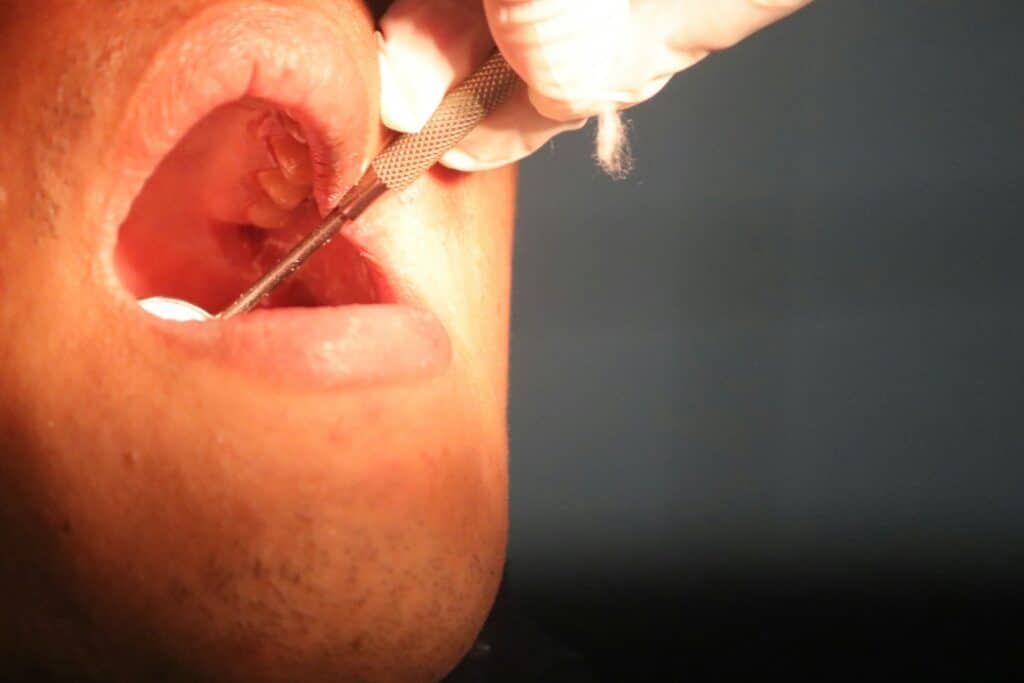
Diabetes can affect a number of your body’s systems, including your mouth. There is an association between diabetes and cavities and mouth sores.
When your blood sugar is high, you may have noticed it dries out your mouth.
The lack of saliva creates an environment in your mouth that is perfect for bacteria growth.
Basically, the excess glucose feeds the bacteria to create plaque. That builds up and causes cavities
Honey, when used in a mouthwash, has been shown to be promising for the prevention of cavities and gum disease.
The compounds in honey can reduce gingivitis, plaque, and even improve bad breath.
Wound healing

One complication that plagues people with diabetes is delayed and complicated wound healing.
Because diabetes can impact your circulation, damaged tissue has difficulty getting the nutrients and blood flow it needs to heal.
While eating honey may not have wound-healing power, topical application of honey has been used for years to fight wound infections and promote healing.
Honey contains hydrogen peroxide and gluconic acid, which prevents pathogen growth and promotes remodeling of new tissue.
It also contains phenols that have an antioxidant action that removes damaged cells. Furthermore, the low pH of honey aids in wound closure.
Decreased inflammation

We hear a lot about inflammation. Inflammation is your body’s natural immune response to injury, infection, or toxic irritants.
Things like bacteria, scrapes, chemical exposure, poor air quality, stress, inadequate sleep, ultra-processed foods, and inactivity can lead to inflammation.
Inflammation triggers multiple cellular pathways to heal and protect your body. This is a good thing. We need our bodies to fight off invasion.
Here’s the thing, it’s not so good if your body remains in that state of inflammation.
Chronic inflammation can cause pain and potentially disrupt insulin signaling and thereby cause high blood sugar. We want to limit inflammation in our body.
Of course, increasing your intake of anti-inflammatory foods (like with the Mediterranean or DASH diet) can help.
Honey is one of those protective foods because of its phenolic and flavonoid compounds.
This 2023 review revealed that honey helped reduce inflammation markers IL-6 and TNF alpha.
Lower blood sugars and cholesterol

If you have diabetes, you probably want to get your blood sugar down.
It’s recommended you spend about 70%, or the bulk of your day in your target range (typically 70-180 mg/dL).
Goals are reached by adjusting medications and insulin, diet, and physical activity, getting adequate sleep, reducing stress, etc.
Easier said than done, right?
The same goes for your cholesterol. Diabetes increases the risk of heart disease, so you may regularly get your cholesterol checked.
I like the approach of adding in beneficial things, rather than taking things away. Honey may be worth an add.
Research has shown that despite its sweetness, honey taken orally (40 grams or ~2 tablespoons) for 8 weeks can reduce fasting blood glucose, total cholesterol, triglycerides, and LDL cholesterol (bad cholesterol).
Does honey raise blood sugar?
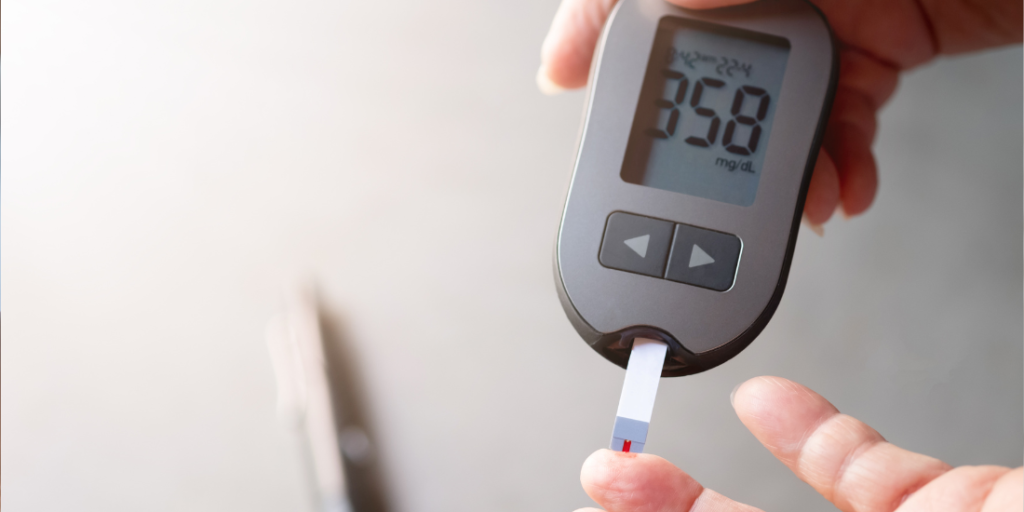
Yes, honey contains carbs and will temporarily raise your blood sugar.
However, when compared to refined sugar, your blood sugars won’t spike as rapidly.
To better understand, let’s briefly discuss the glycemic index (GI). The glycemic index is a scale used to determine how quickly a certain food will raise your blood sugar.
Then food is classified as low, medium, or high:
- Low GI: 55 or less
- Medium GI: 56 to 69
- High GI: 70 or above
Ideally, you’d choose foods that are in the low-medium category. Of course, you can eat foods that have a higher GI, but you’ll likely have higher blood sugars as a result.
The good news is that honey can be a way to honor your cravings without having high blood sugars all day.
Honey is composed of more fructose—a naturally occurring sweetener—than other sweeteners.
Fructose has a glycemic index of 19, whereas refined sugar has a glycemic index of 60.
That means honey is a better choice than sugar when choosing a sweetener. If you use honey instead of sugar, you may find your blood sugars improved.
While researchers haven’t pinned down the reason, honey has a long-term blood sugar-lowering effect.
What is the best honey for diabetes?

There are a lot of varieties of honey, so which one is best for diabetes?
The research tends to point to raw honey.
While the pasteurization process may reduce the risk of your honey crystallizing, raw honey can last a long time.
So I’d go with raw over pasteurized to get all of the powerful antioxidants and enzymes. Some options include:
- Nate’s Organic 100% Pure, Raw & Unfiltered Honey
- Y.S. Eco Bee Farms Raw Honey
- Amazon Fresh, Raw Wildflower Honey
- Wholesome Sweeteners Organic Raw Unfiltered Honey
Although it’s pricier, Manuka honey for diabetes also deserves special attention for its antimicrobial properties.
Look for labels showing the levels of methylglyoxal (MGO), a compound with antibacterial properties, and the “Unique Manuka Factor” (UMF), which corresponds with the MGO content.
The higher the MGO, the better it is.
Here are some high-quality Manuka honey options:
- Manuka Doctor MGO 925+ Manuka Honey
- Comvita Manuka Honey (UMF 15+, MGO 514+)
- Manuka Health UMF 13+/MGO 400+ Manuka Honey
- Kiva Raw Manuka Honey UMF 20+ | MGO 850+
- New Zealand Honey Co. Raw Manuka Honey UMF 20+ | MGO 829+
How to use honey for diabetes
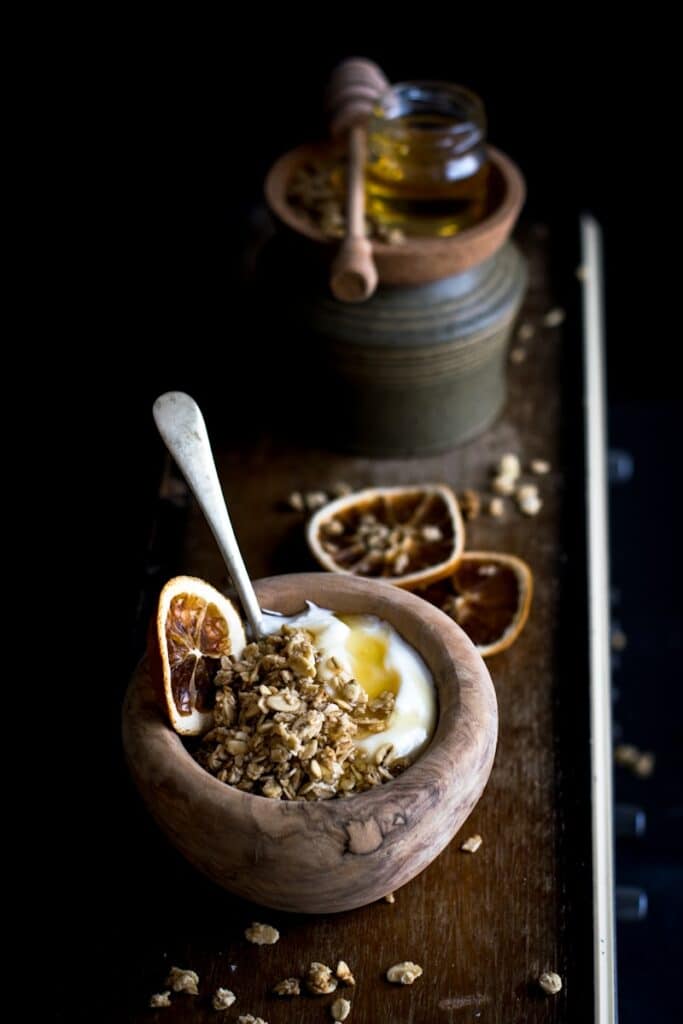
So you’re convinced honey is the sweetener for you. Now just how much do you use? And when?
You don’t need much. Most of the research included a daily serving of about 2 tablespoons.
Honey still has about 17 grams of carbs per tablespoon, so you will want to factor that in when you are adjusting your insulin.
As we previously discussed, because it has a lower GI, 17 grams of carbs coming from honey will react differently in your body than 17 grams of carbs from refined sugar.
You’ll have to see how your blood sugars respond after a serving of honey.
How you can substitute honey for sugar
A good place to start is to swap out your sugar for honey. Honey is a good substitute for sugar for people with diabetes.
- Coffee: If you take sugar or sweetened creamer in your coffee, use honey instead.
- Toast: Next time you have peanut butter toast, try a bit of honey on top.
- Dressing: I like to make a simple vinaigrette dressing for my chopped kale salad recipe. I’ll often use honey as a sweetener.
- Tea: Honey is a popular sweetener for tea, and you can get a double dose of antioxidants.
- Oatmeal: You can add it to your oatmeal with some almonds or walnuts for a well-rounded breakfast.
- Greek yogurt: Most flavored yogurts have a lot of added sugar. Instead, I’ll buy the plain Greek yogurt and sweeten it with honey.
- Pancake or waffle topping: Instead of syrup, try drizzling a bit of honey.
- Recipes: For every 1 cup of sugar, use 3/4 cup of honey. Since honey is a liquid, you can reduce the other liquid ingredients in the recipe by about 1/4 cup for every cup of honey used. You may also have to adjust for the acidity of honey. To balance, add 1/4 teaspoon of baking soda for every cup of honey used.
The bottom line is that honey can be a good option for someone with diabetes. Using honey instead of refined sugar can satisfy your sweet tooth and provide health benefits.
Insurance often covers diabetes and nutrition education
I am now working with Nourish to accept insurance to make your nutrition appointment affordable. Click on the button below to start the process and see if your visit is covered by insurance.
References
- Mauri-Obradors E, Estrugo-Devesa A, Jané-Salas E, Viñas M, López-López J. Oral manifestations of Diabetes Mellitus. A systematic review. Med Oral Patol Oral Cir Bucal. 2017;22(5):e586-e594. Published 2017 Sep 1. doi:10.4317/medoral.21655
- Otręba M, Marek Ł, Tyczyńska N, Stojko J, Rzepecka-Stojko A. Bee Venom, Honey, and Royal Jelly in the Treatment of Bacterial Infections of the Oral Cavity: A Review. Life (Basel). 2021;11(12):1311. Published 2021 Nov 28. doi:10.3390/life11121311
- Ramsay EI, Rao S, Madathil L, et al. Honey in oral health and care: A mini review. J Oral Biosci. 2019;61(1):32-36. doi:10.1016/j.job.2018.12.003
- Yupanqui Mieles J, Vyas C, Aslan E, Humphreys G, Diver C, Bartolo P. Honey: An Advanced Antimicrobial and Wound Healing Biomaterial for Tissue Engineering Applications. Pharmaceutics. 2022;14(8):1663. Published 2022 Aug 10. doi:10.3390/pharmaceutics14081663
- Ranneh Y, Akim AM, Hamid HA, et al. Honey and its nutritional and anti-inflammatory value. BMC Complement Med Ther. 2021;21(1):30. Published 2021 Jan 14. doi:10.1186/s12906-020-03170-5
- Ahmed A, Tul-Noor Z, Lee D, et al. Effect of honey on cardiometabolic risk factors: a systematic review and meta-analysis. Nutr Rev. 2023;81(7):758-774. doi:10.1093/nutrit/nuac086
- Bantle JP. Dietary fructose and metabolic syndrome and diabetes. J Nutr. 2009;139(6):1263S-1268S. doi:10.3945/jn.108.098020
- Bobiş O, Dezmirean DS, Moise AR. Honey and Diabetes: The Importance of Natural Simple Sugars in Diet for Preventing and Treating Different Type of Diabetes. Oxid Med Cell Longev. 2018;2018:4757893. Published 2018 Feb 4. doi:10.1155/2018/4757893
- Niaz K, Maqbool F, Bahadar H, Abdollahi M. Health Benefits of Manuka Honey as an Essential Constituent for Tissue Regeneration. Curr Drug Metab. 2017;18(10):881-892. doi:10.2174/1389200218666170911152240
About the author
Erin is a registered dietitian and diabetes educator with almost 20 years of experience. She specializes in weight-inclusive diabetes care and prevention, intuitive eating, fitness, and women’s health. She works as a consultant and writer in the health and wellness space. Erin is passionate about empowering people to manage their own health and to have peace with food.

